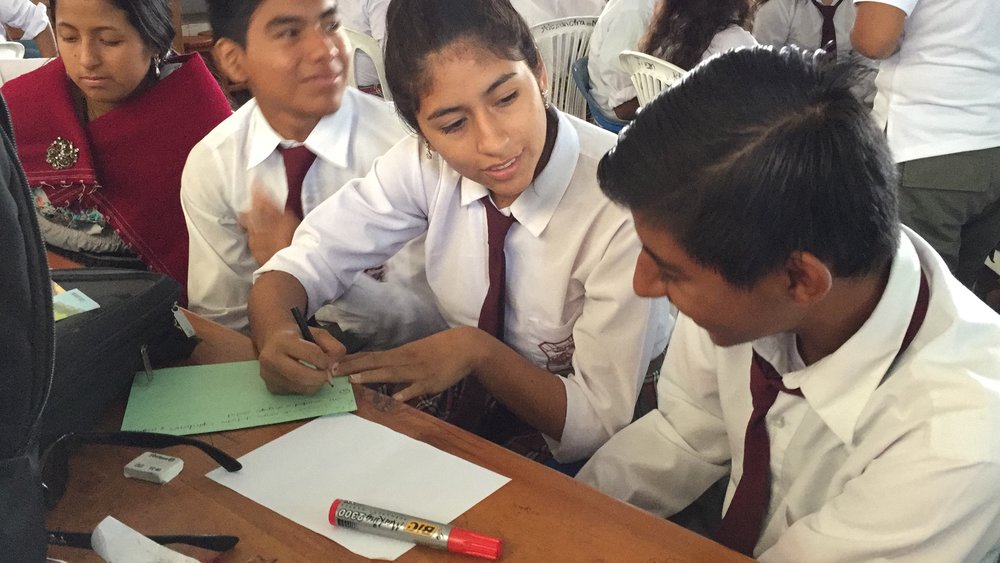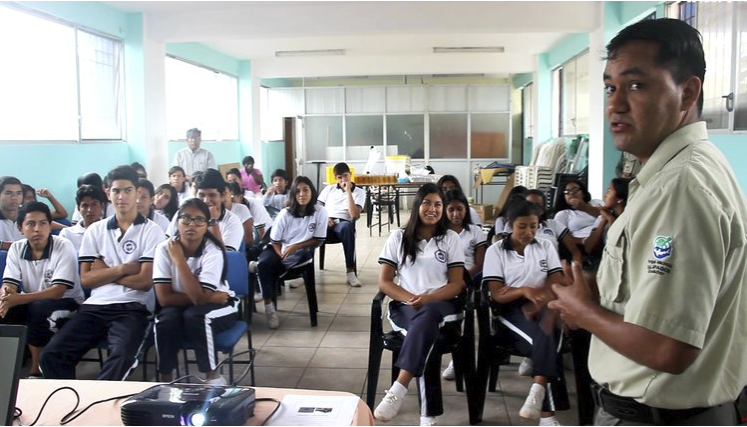Elvis Llerena, Tania Quisingo, Roberto Maldonado
Galapagos National Park Directorate

Figure 1. Students reflect on the idea of Galapagos identity. Photo: Galapagos National Park Directorate Archives
People actually live in Galapagos? While this may seem like a silly question for those of us who know the Islands, it’s not an uncommon one among people on mainland Ecuador and around the world. Many people have heard about the unique flora, fauna and geological formations of Galapagos, but very little is known about its local communities, their history and culture.
Unlike other archipelagos with long histories of human settlement, the vast majority of the 25,000 inhabitants of Galapagos are immigrants, most having arrived during the second half of the last century in different waves of migration from mainland Ecuador and other countries.
Life in Galapagos is different in many ways from life on the continent. Migrating to the Islands involves a process of assimilation to the geographic and environmental conditions in the Archipelago. This process includes getting used to proper trash disposal practices, a heavy reliance on products shipped from the continent, the almost obligatory use of alternative means of transportation, like inter-island ferries and bikes, and dependence on planes and cargo ships.
If we were to define what is means to be “galapagueño,” we might say that it refers to an attachment to a group of islands inhabited by people from different places who are connected by a fragile and unique ecosystem. However, important topics such as cultural identity and Galapagos history are not widely discussed.
WORKSHOPS ON CULTURAL IDENTITY
To stimulate dialogue and build awareness about what it means to be galapagueño, the Environmental Education team of the Galapagos National Park Directorate has presented workshops on cultural identity to students throughout the Islands for the last two years.
To initiate a process of self-reflection, we share different theories related to cultural identity. Students then work together to describe the cultural behavior of those living in Galapagos with respect to matters such as food (typical dishes), the use of free time (athletic, cultural and recreational activities), forms of transportation, and holidays and public celebrations (cultural and religious celebrations). The personal experiences of each student enrich these discussions.
Next, we help students think about their connection with the Galapagos environment and environmental services. We encourage them to adopt attitudes that support care and protection of emblematic species, responsible use of water and energy, recycling, and the use of technology that is compatible with the fragile island ecosystems.
We conclude by walking students through the human history of Galapagos, from pre-Columbian times through events such as Ecuador’s annexation of the Islands and their third provincialization in 1973. We then serve students micha (a traditional tortilla-like bread) and lemongrass water — foods consumed by the first Galapagos settlers and still enjoyed today.

Figure 2. Culture identity workshop. Photo: Galapagos National Park Directorate Archives
In 2016 and 2017 we conducted two rounds of workshops in Santa Cruz (59 workshops in all), with the participation of 1,571 students in their first, second and third years of high school.
NEXT STEPS
These workshops allow students to take a trip through time that exposes them to the human history of the Islands and encourages them to develop their own understanding of Galapagos culture. The workshops also strengthen the relationship between the Galapagos National Park Directorate and local schools. We plan to continue these activities annually in all Galapagos schools, in order to help young people to develop a greater sense of belonging and to value their Galapagos identity.
ACKNOWLEDGEMENTS
We would like to thank the Ministry of Culture and Heritage, the Casa de Cultura, Galápagos Núcleo, the Ministry of Education and the schools and students of Santa Cruz who participated in these events.
